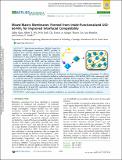| dc.contributor.author | Qian, Qihui | |
| dc.contributor.author | Wu, Albert X. | |
| dc.contributor.author | Chi, Won Seok | |
| dc.contributor.author | Asinger, Patrick Andrew | |
| dc.contributor.author | Lin, Sharon | |
| dc.contributor.author | Hypsher, Asia J. | |
| dc.contributor.author | Smith, Zachary P | |
| dc.date.accessioned | 2019-09-12T21:00:28Z | |
| dc.date.available | 2019-09-12T21:00:28Z | |
| dc.date.issued | 2019-07 | |
| dc.date.submitted | 2019-04 | |
| dc.identifier.issn | 1944-8244 | |
| dc.identifier.issn | 1944-8252 | |
| dc.identifier.uri | https://hdl.handle.net/1721.1/122057 | |
| dc.description.abstract | Mixed-matrix membranes (MMMs) formed by dispersing metal-organic framework (MOF) particles in polymers have attracted significant attention because these composite systems can potentially surpass the separation performance of pure polymers alone. However, performance improvements are often unrealized because of poor interfacial compatibility between the MOF and the polymer, which results in interfacial defects. From a practical perspective, strategies are needed to address these defects so that MMMs can be deployed in real-world separation processes. From a fundamental perspective, strategies are needed to reliably form defect-free MMMs so that transport models can be applied to estimate pure MOF property sets, thereby enabling the development of robust structure-property relationships. To address these interfacial challenges, we have developed a method to surface-functionalize a UiO-66-NH₂ MOF with a nanoscopic shell of covalently tethered 4,4'-(hexafluoroisopropylidene)diphthalic anhydride-Durene oligomers. When combined with a high-molecular-weight polymer of identical chemical structure to that of the imide-functional MOF surface, defect-free MMMs with uniform particle dispersions can be formed. With this technique, both permeabilities and selectivities of select gases in the MMMs were improved at loadings ranging from 5 to 40 wt %. At a 40 wt % loading, CO₂ permeability and CO₂/CH₄ selectivity were enhanced by 48 and 15%, respectively. Additionally, pure MOF permeabilities for H₂, N₂, O₂, CH₄, and CO₂ were predicted by the Maxwell model. Keywords: metal-organic frameworks; postsynthetic modification; gas separations; polyimides; mixed-matrix membranes | en_US |
| dc.language.iso | en | |
| dc.publisher | American Chemical Society (ACS) | en_US |
| dc.relation.isversionof | http://dx.doi.org/10.1021/acsami.9b07500 | en_US |
| dc.rights | Creative Commons Attribution-NonCommercial-NoDerivs License | en_US |
| dc.rights.uri | http://creativecommons.org/licenses/by-nc-nd/4.0/ | en_US |
| dc.source | ACS | en_US |
| dc.title | Mixed-Matrix Membranes Formed from Imide-Functionalized UiO-66-NH2 for Improved Interfacial Compatibility | en_US |
| dc.type | Article | en_US |
| dc.identifier.citation | Qian, Qihui et al. "Mixed-Matrix Membranes Formed from Imide-Functionalized UiO-66-NH₂ for Improved Interfacial Compatibility." ACS Applied Materials & Interfaces 11, 34 (July 2019): 31257-31269 © 2019 American Chemical Society | en_US |
| dc.contributor.department | Massachusetts Institute of Technology. Department of Chemical Engineering | en_US |
| dc.relation.journal | ACS Applied Materials & Interfaces | en_US |
| dc.eprint.version | Final published version | en_US |
| dc.type.uri | http://purl.org/eprint/type/JournalArticle | en_US |
| eprint.status | http://purl.org/eprint/status/PeerReviewed | en_US |
| dc.date.updated | 2019-09-11T17:22:10Z | |
| dspace.date.submission | 2019-09-11T17:22:17Z | |
| mit.journal.volume | 11 | en_US |
| mit.journal.issue | 34 | en_US |
